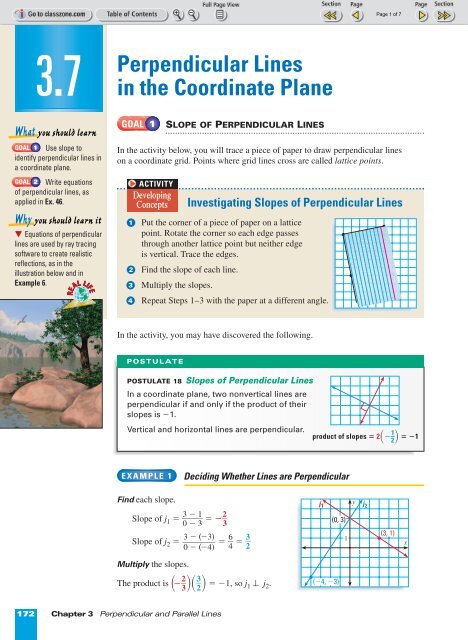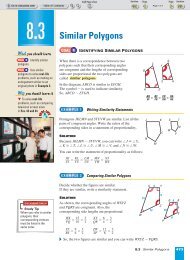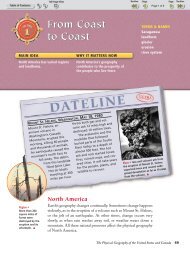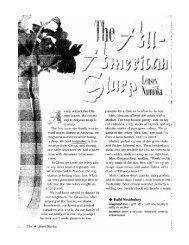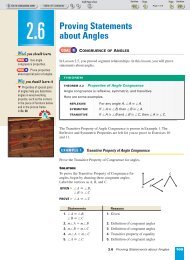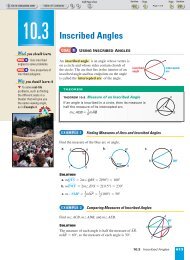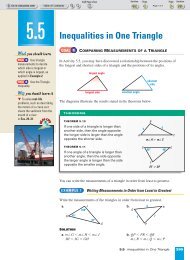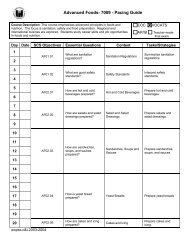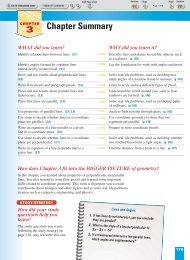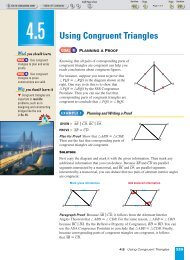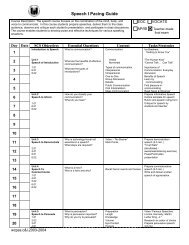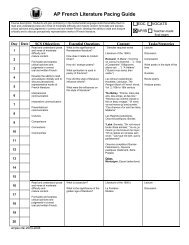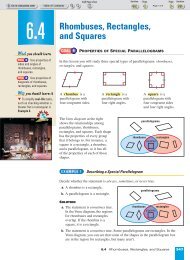3-7 Perpendicular Lines in the Coordinate Plane - Nexuslearning.net
3-7 Perpendicular Lines in the Coordinate Plane - Nexuslearning.net
3-7 Perpendicular Lines in the Coordinate Plane - Nexuslearning.net
You also want an ePaper? Increase the reach of your titles
YUMPU automatically turns print PDFs into web optimized ePapers that Google loves.
3.7<br />
What you should learn<br />
GOAL 1 Use slope to<br />
identify perpendicular l<strong>in</strong>es <strong>in</strong><br />
a coord<strong>in</strong>ate plane.<br />
GOAL 2 Write equations<br />
of perpendicular l<strong>in</strong>es, as<br />
applied <strong>in</strong> Ex. 46.<br />
Why you should learn it<br />
Equations of perpendicular<br />
l<strong>in</strong>es are used by ray trac<strong>in</strong>g<br />
software to create realistic<br />
reflections, as <strong>in</strong> <strong>the</strong><br />
illustration below and <strong>in</strong><br />
Example 6.<br />
REAL<br />
REAL LIFE<br />
LIFE<br />
<strong>Perpendicular</strong> <strong>L<strong>in</strong>es</strong><br />
<strong>in</strong> <strong>the</strong> Coord<strong>in</strong>ate <strong>Plane</strong><br />
GOAL 1<br />
172 Chapter 3 <strong>Perpendicular</strong> and Parallel <strong>L<strong>in</strong>es</strong><br />
SLOPE OF PERPENDICULAR LINES<br />
In <strong>the</strong> activity below, you will trace a piece of paper to draw perpendicular l<strong>in</strong>es<br />
on a coord<strong>in</strong>ate grid. Po<strong>in</strong>ts where grid l<strong>in</strong>es cross are called lattice po<strong>in</strong>ts.<br />
1<br />
2<br />
3<br />
4<br />
ACTIVITY<br />
Develop<strong>in</strong>g<br />
Concepts<br />
LESSON INVESTIGATION<br />
In <strong>the</strong> activity, you may have discovered <strong>the</strong> follow<strong>in</strong>g.<br />
POSTULATE<br />
EXAMPLE 1<br />
F<strong>in</strong>d each slope.<br />
Slope of j 1 = 3<br />
0<br />
Investigat<strong>in</strong>g Slopes of <strong>Perpendicular</strong> <strong>L<strong>in</strong>es</strong><br />
Put <strong>the</strong> corner of a piece of paper on a lattice<br />
po<strong>in</strong>t. Rotate <strong>the</strong> corner so each edge passes<br />
through ano<strong>the</strong>r lattice po<strong>in</strong>t but nei<strong>the</strong>r edge<br />
is vertical. Trace <strong>the</strong> edges.<br />
F<strong>in</strong>d <strong>the</strong> slope of each l<strong>in</strong>e.<br />
Multiply <strong>the</strong> slopes.<br />
Repeat Steps 1–3 with <strong>the</strong> paper at a different angle.<br />
POSTULATE<br />
POSTULATE 18 Slopes of <strong>Perpendicular</strong> <strong>L<strong>in</strong>es</strong><br />
In a coord<strong>in</strong>ate plane, two nonvertical l<strong>in</strong>es are<br />
perpendicular if and only if <strong>the</strong> product of <strong>the</strong>ir<br />
slopes is º1.<br />
Vertical and horizontal l<strong>in</strong>es are perpendicular.<br />
Decid<strong>in</strong>g Whe<strong>the</strong>r <strong>L<strong>in</strong>es</strong> are <strong>Perpendicular</strong><br />
º 1 2<br />
= º º 3 3<br />
Slope of j2 = = 6<br />
= 3<br />
4 2 <br />
3º(º3)<br />
<br />
0 º (º4)<br />
Multiply <strong>the</strong> slopes.<br />
2<br />
The product is º 3<br />
3<br />
2 = º1, so j1 fi j2 .<br />
product of slopes = 2º} 1 } =º1<br />
2<br />
j 1<br />
(0, 3)<br />
(4, 3)<br />
1<br />
y<br />
1<br />
j 2<br />
(3, 1)<br />
x
Logical<br />
Reason<strong>in</strong>g<br />
xy xy<br />
Us<strong>in</strong>g<br />
Algebra<br />
EXAMPLE 2<br />
Decid<strong>in</strong>g Whe<strong>the</strong>r <strong>L<strong>in</strong>es</strong> are <strong>Perpendicular</strong><br />
Decide whe<strong>the</strong>r AC<br />
¯˘ and DB<br />
¯˘ are perpendicular.<br />
SOLUTION<br />
Slope of AC<br />
¯˘ = = 6<br />
= 2<br />
3<br />
Slope of DB<br />
¯˘ 3<br />
= = = º<br />
º 6<br />
1<br />
2 <br />
2 º(º4)<br />
<br />
4º1<br />
2 º(º1)<br />
<br />
º1 º 5<br />
The product is 2º 1<br />
2 = º1, so AC<br />
¯˘ fi DB<br />
¯˘ .<br />
EXAMPLE 3<br />
Decid<strong>in</strong>g Whe<strong>the</strong>r <strong>L<strong>in</strong>es</strong> are <strong>Perpendicular</strong><br />
Decide whe<strong>the</strong>r <strong>the</strong> l<strong>in</strong>es are perpendicular.<br />
l<strong>in</strong>e h: y = 3<br />
x + 2 l<strong>in</strong>e j: y = º4 x º 3<br />
4 3<br />
SOLUTION<br />
The slope of l<strong>in</strong>e h is 3<br />
. The slope of l<strong>in</strong>e j is º4<br />
4 3 .<br />
The product is 3 4<br />
º 4 3 = º1, so <strong>the</strong> l<strong>in</strong>es are perpendicular.<br />
EXAMPLE 4<br />
Decid<strong>in</strong>g Whe<strong>the</strong>r <strong>L<strong>in</strong>es</strong> are <strong>Perpendicular</strong><br />
Decide whe<strong>the</strong>r <strong>the</strong> l<strong>in</strong>es are perpendicular.<br />
SOLUTION<br />
l<strong>in</strong>e r: 4x + 5y = 2 l<strong>in</strong>e s: 5x + 4y = 3<br />
Rewrite each equation <strong>in</strong> slope-<strong>in</strong>tercept form to f<strong>in</strong>d <strong>the</strong> slope.<br />
l<strong>in</strong>e r: l<strong>in</strong>e s:<br />
4x + 5y = 2 5x +4y = 3<br />
5y = º4x + 2 4y = º5x + 3<br />
y = º 4<br />
x + 2 <br />
5 5<br />
y = º5<br />
4 x + 3<br />
<br />
4<br />
slope = º 4<br />
<br />
5<br />
slope = º5<br />
4 <br />
Multiply <strong>the</strong> slopes to see if <strong>the</strong> l<strong>in</strong>es are perpendicular.<br />
º 4 5<br />
º 5 4 =1<br />
The product of <strong>the</strong> slopes is not º1. So, r and s are not perpendicular.<br />
3.7 <strong>Perpendicular</strong> <strong>L<strong>in</strong>es</strong> <strong>in</strong> <strong>the</strong> Coord<strong>in</strong>ate <strong>Plane</strong> 173<br />
y<br />
B(1, 2) C(4, 2)<br />
1<br />
1<br />
A(1, 4)<br />
D(5, 1)<br />
x
GRAPHIC ARTS<br />
Many graphic artists<br />
use computer software to<br />
design images.<br />
CAREER LINK<br />
www.mcdougallittell.com<br />
REAL<br />
REAL LIFE<br />
LIFE<br />
INTERNET<br />
STUDENT HELP<br />
Study Tip<br />
You can check m 2 by<br />
multiply<strong>in</strong>g m 1 • m 2 .<br />
(º2) 1<br />
2 =º1 ✓<br />
FOCUS ON<br />
CAREERS<br />
GOAL 2<br />
EXAMPLE 5<br />
174 Chapter 3 <strong>Perpendicular</strong> and Parallel <strong>L<strong>in</strong>es</strong><br />
WRITING EQUATIONS OF PERPENDICULAR LINES<br />
Writ<strong>in</strong>g <strong>the</strong> Equation of a <strong>Perpendicular</strong> L<strong>in</strong>e<br />
L<strong>in</strong>e l1 has equation y = º2x + 1. F<strong>in</strong>d an equation of <strong>the</strong> l<strong>in</strong>e l2 that passes<br />
through P(4, 0) and is perpendicular to l1 . First you must f<strong>in</strong>d <strong>the</strong> slope, m2 .<br />
m1 • m2 =º1 The product of <strong>the</strong> slopes of fi l<strong>in</strong>es is º1.<br />
º2 • m2 =º1 The slope of l1 is º2.<br />
m2 = 1<br />
<br />
2<br />
Divide both sides by º2.<br />
Then use m = 1<br />
and (x, y) = (4, 0) to f<strong>in</strong>d b.<br />
2<br />
y = mx + b Slope-<strong>in</strong>tercept form<br />
0= 1<br />
(4) + b Substitute 0 for y, }1 } for m, and 4 for x.<br />
2 2<br />
º2 = b Simplify.<br />
So, an equation of l2 is y = 1<br />
2<br />
. . . . . . . . . .<br />
x º2.<br />
RAY TRACING Computer illustrators use ray<br />
trac<strong>in</strong>g to make accurate reflections. To figure<br />
out what to show <strong>in</strong> <strong>the</strong> mirror, <strong>the</strong> computer<br />
traces a ray of light as it reflects off <strong>the</strong> mirror.<br />
This calculation has many steps. One of <strong>the</strong><br />
first steps is to f<strong>in</strong>d <strong>the</strong> equation of a l<strong>in</strong>e<br />
perpendicular to <strong>the</strong> mirror.<br />
EXAMPLE 6<br />
Writ<strong>in</strong>g <strong>the</strong> Equation of a <strong>Perpendicular</strong> L<strong>in</strong>e<br />
The equation y = 3<br />
x + 3 represents a mirror.<br />
2<br />
A ray of light hits <strong>the</strong> mirror at (º2, 0). What<br />
is <strong>the</strong> equation of <strong>the</strong> l<strong>in</strong>e p that is<br />
perpendicular to <strong>the</strong> mirror at this po<strong>in</strong>t?<br />
SOLUTION<br />
The mirror’s slope is 3<br />
, so <strong>the</strong> slope of p is º2<br />
2 3 .<br />
Use m = º 2<br />
and (x, y) = (º2, 0) to f<strong>in</strong>d b.<br />
3<br />
0= º 2<br />
(º2) + b<br />
3<br />
º 4<br />
= b<br />
3<br />
So, an equation for p is y = º 2<br />
x º 4<br />
3 3 .<br />
1<br />
Top view of mirror<br />
y<br />
1<br />
3<br />
y x 3<br />
2<br />
ray of light<br />
p<br />
x
GUIDED PRACTICE<br />
Vocabulary Check ✓<br />
Concept Check ✓<br />
Skill Check ✓<br />
PRACTICE AND APPLICATIONS<br />
STUDENT HELP<br />
Extra Practice<br />
to help you master<br />
skills is on p. 808.<br />
STUDENT HELP<br />
HOMEWORK HELP<br />
Example 1: Exs. 7–20<br />
Example 2: Exs. 21–24,<br />
33–37<br />
Example 3: Exs. 25–28,<br />
47–50<br />
Example 4: Exs. 29–32<br />
Example 5: Exs. 38–41<br />
Example 6: Exs. 42–46<br />
1. Def<strong>in</strong>e slope of a l<strong>in</strong>e.<br />
2. The slope of l<strong>in</strong>e m is º 1<br />
. What is <strong>the</strong> slope of a l<strong>in</strong>e perpendicular to m?<br />
5<br />
3. In <strong>the</strong> coord<strong>in</strong>ate plane shown at <strong>the</strong> right, is<br />
¯˘ ¯˘<br />
AC perpendicular to BD?<br />
Expla<strong>in</strong>.<br />
A(1, 3)<br />
3<br />
y<br />
4. Decide whe<strong>the</strong>r <strong>the</strong> l<strong>in</strong>es with <strong>the</strong> equations<br />
y = 2x º 1 and y = º2x + 1 are perpendicular.<br />
5. Decide whe<strong>the</strong>r <strong>the</strong> l<strong>in</strong>es with <strong>the</strong> equations<br />
5y º x = 15 and y + 5x = 2 are perpendicular.<br />
B(2, 0)<br />
1<br />
D(2, 2)<br />
C(1, 1)<br />
6. The l<strong>in</strong>e l 1 has <strong>the</strong> equation y = 3x. The l<strong>in</strong>e l 2 is perpendicular to l 1 and<br />
passes through <strong>the</strong> po<strong>in</strong>t P(0, 0). Write an equation of l 2 .<br />
SLOPES OF PERPENDICULAR LINES The slopes of two l<strong>in</strong>es are given.<br />
Are <strong>the</strong> l<strong>in</strong>es perpendicular?<br />
7. m1 = 2, m2 =º 1<br />
2 8. m1 = 2<br />
3 , m2 = 3<br />
2 9. m1 = 1<br />
4 , m2 =º4<br />
10. m 1 = 5<br />
7 , m 2 =º7<br />
5 11. m 1 =º 1<br />
2 , m 2 =º1<br />
2 12. m 1 = º1, m 2 =1<br />
SLOPES OF PERPENDICULAR LINES <strong>L<strong>in</strong>es</strong> j and n are perpendicular. The<br />
slope of l<strong>in</strong>e j is given. What is <strong>the</strong> slope of l<strong>in</strong>e n? Check your answer.<br />
13. 2 14. 5 15. º3 16. º7<br />
17. 2<br />
<br />
3<br />
18. 1 <br />
5<br />
19. º1<br />
3 20. º 4<br />
<br />
3<br />
IDENTIFYING PERPENDICULAR LINES F<strong>in</strong>d <strong>the</strong> slope of AC<br />
¯˘ and BD<br />
¯˘ .<br />
Decide whe<strong>the</strong>r AC<br />
¯˘ is perpendicular to BD<br />
¯˘ .<br />
21. y<br />
22.<br />
2<br />
B(3, 2) C(0, 1)<br />
A(1, 2)<br />
23. y<br />
24.<br />
B(2, 3)<br />
A(2, 1)<br />
1<br />
1<br />
1<br />
D(0, 2)<br />
C(4, 1)<br />
D(3, 0)<br />
x<br />
x<br />
A(3, 0)<br />
B(1, 1)<br />
1<br />
C(3, 0)<br />
1<br />
A(1, 3)<br />
B(4, 3)<br />
C(2, 2)<br />
D(2, 0)<br />
3.7 <strong>Perpendicular</strong> <strong>L<strong>in</strong>es</strong> <strong>in</strong> <strong>the</strong> Coord<strong>in</strong>ate <strong>Plane</strong> 175<br />
1<br />
y<br />
y<br />
D(1, 2)<br />
5<br />
x<br />
x<br />
x
STUDENT HELP<br />
HOMEWORK HELP<br />
Visit our Web site<br />
www.mcdougallittell.com<br />
for help with Exs. 33–36.<br />
INTERNET<br />
xy xy USING ALGEBRA Decide whe<strong>the</strong>r l<strong>in</strong>es k1 and k2 are perpendicular.<br />
Then graph <strong>the</strong> l<strong>in</strong>es to check your answer.<br />
25. l<strong>in</strong>e k1 : y = 3x 26. l<strong>in</strong>e k1 : y = º 4<br />
x º 2<br />
5<br />
l<strong>in</strong>e k2 : y = º 1<br />
3 x º 2 l<strong>in</strong>e k2 : y = 1 x + 4<br />
5<br />
27. l<strong>in</strong>e k 1 : y = º 3<br />
4 x + 2 28. l<strong>in</strong>e k 1<br />
176 Chapter 3 <strong>Perpendicular</strong> and Parallel <strong>L<strong>in</strong>es</strong><br />
: y = 1 x º 10<br />
3<br />
l<strong>in</strong>e k2 : y = 4<br />
3 x + 5 l<strong>in</strong>e k2 : y = 3x<br />
xy xy USING ALGEBRA Decide whe<strong>the</strong>r l<strong>in</strong>es p1 and p2 are perpendicular.<br />
29. l<strong>in</strong>e p1 : 3y º 4x = 3 30. l<strong>in</strong>e p1 : y º 6x = 2<br />
l<strong>in</strong>e p 2 : 4y + 3x = º12 l<strong>in</strong>e p 2 : 6y º x = 12<br />
31. l<strong>in</strong>e p 1 : 3y + 2x = º36 32. l<strong>in</strong>e p 1 : 5y + 3x = º15<br />
l<strong>in</strong>e p 2 : 4y º 3x = 16 l<strong>in</strong>e p 2 : 3y º 5x = º33<br />
LINE RELATIONSHIPS F<strong>in</strong>d <strong>the</strong> slope of each l<strong>in</strong>e. Identify any parallel or<br />
perpendicular l<strong>in</strong>es.<br />
33. y œ<br />
34.<br />
W<br />
P<br />
35. y<br />
Z 36.<br />
C S<br />
R<br />
A<br />
B<br />
1<br />
V<br />
1<br />
A<br />
1<br />
37. NEEDLEPOINT To check whe<strong>the</strong>r two<br />
stitched l<strong>in</strong>es make a right angle, you can<br />
count <strong>the</strong> squares. For example, <strong>the</strong> l<strong>in</strong>es at<br />
<strong>the</strong> right are perpendicular because one<br />
goes up 8 as it goes over 4, and <strong>the</strong> o<strong>the</strong>r<br />
goes over 8 as it goes down 4. Why does<br />
this mean <strong>the</strong> l<strong>in</strong>es are perpendicular?<br />
D<br />
2<br />
WRITING EQUATIONS L<strong>in</strong>e j is perpendicular to <strong>the</strong> l<strong>in</strong>e with <strong>the</strong> given<br />
equation and l<strong>in</strong>e j passes through P. Write an equation of l<strong>in</strong>e j.<br />
38. y = 1<br />
x º 1, P(0, 3) 39. y = 5 x + 2, P(5, 1)<br />
2 3<br />
40. y = º4x º 3, P(º2, 2) 41. 3y + 4x = 12, P(º3, º4)<br />
x<br />
x<br />
K<br />
8<br />
F<br />
2<br />
S<br />
y<br />
œ<br />
1 L<br />
P<br />
4 8<br />
H<br />
y<br />
2<br />
T<br />
G<br />
O<br />
E<br />
4<br />
2<br />
R<br />
x<br />
x
HELAMAN<br />
FERGUSON’S<br />
stone drill is suspended by<br />
six cables. The computer<br />
uses <strong>the</strong> lengths of <strong>the</strong><br />
cables to calculate <strong>the</strong><br />
coord<strong>in</strong>ates of <strong>the</strong> drill tip.<br />
REAL<br />
REAL LIFE<br />
LIFE<br />
FOCUS ON<br />
PEOPLE<br />
Test<br />
Preparation<br />
★ Challenge<br />
EXTRA CHALLENGE<br />
www.mcdougallittell.com<br />
WRITING EQUATIONS The l<strong>in</strong>e with <strong>the</strong> given equation is perpendicular to<br />
l<strong>in</strong>e j at po<strong>in</strong>t R. Write an equation of l<strong>in</strong>e j.<br />
42. y = º 3<br />
x + 6, R(8, 0)<br />
4<br />
43. y = 1 x º 11, R(7, º10)<br />
7<br />
44. y = 3x + 5, R(º3, º4) 45. y = º 2<br />
x º 3, R(5, º5)<br />
5<br />
46. SCULPTURE Helaman Ferguson designs sculptures on a computer. The<br />
computer is connected to his stone drill and tells how far he should drill at<br />
any given po<strong>in</strong>t. The distance from <strong>the</strong> drill tip to <strong>the</strong> desired surface of <strong>the</strong><br />
sculpture is calculated along a l<strong>in</strong>e perpendicular to <strong>the</strong> sculpture.<br />
Suppose <strong>the</strong> drill tip is at<br />
(º1, º1) and <strong>the</strong> equation<br />
y = 1<br />
x + 3 represents <strong>the</strong><br />
4<br />
surface of <strong>the</strong> sculpture. Write<br />
an equation of <strong>the</strong> l<strong>in</strong>e that<br />
passes through <strong>the</strong> drill tip and<br />
is perpendicular to <strong>the</strong> sculpture.<br />
LINE RELATIONSHIPS Decide whe<strong>the</strong>r <strong>the</strong> l<strong>in</strong>es with <strong>the</strong> given equations<br />
are parallel, perpendicular, or nei<strong>the</strong>r.<br />
47. y = º2x º 1 48. y = º 1<br />
x + 3<br />
2<br />
49. y = º3x + 1 50. y = 4x + 10<br />
y = º2x º 3 y = º 1<br />
x + 5<br />
2<br />
y = 1 x + 1<br />
3<br />
y = º2x + 5<br />
51. MULTI-STEP PROBLEM Use <strong>the</strong> diagram<br />
at <strong>the</strong> right.<br />
a. Is l 1 ∞ l 2 ? How do you know?<br />
b. Is l 2 fi n? How do you know?<br />
c. Writ<strong>in</strong>g Describe two ways to prove<br />
that l 1 fi n.<br />
DISTANCE TO A LINE In Exercises 52–54,<br />
use <strong>the</strong> follow<strong>in</strong>g <strong>in</strong>formation.<br />
The distance from a po<strong>in</strong>t to a l<strong>in</strong>e is<br />
def<strong>in</strong>ed to be <strong>the</strong> length of <strong>the</strong><br />
perpendicular segment from <strong>the</strong> po<strong>in</strong>t to<br />
<strong>the</strong> l<strong>in</strong>e. In <strong>the</strong> diagram at <strong>the</strong> right, <strong>the</strong><br />
distance d between po<strong>in</strong>t P and l<strong>in</strong>e l is<br />
given by QP.<br />
52. F<strong>in</strong>d an equation of QP<br />
¯˘ .<br />
53. Solve a system of equations to f<strong>in</strong>d <strong>the</strong> coord<strong>in</strong>ates of po<strong>in</strong>t Q, <strong>the</strong><br />
<strong>in</strong>tersection of <strong>the</strong> two l<strong>in</strong>es.<br />
54. Use <strong>the</strong> Distance Formula to f<strong>in</strong>d QP.<br />
sculpture<br />
2<br />
y<br />
(1, 1)<br />
1<br />
L y<br />
1 L2 n<br />
3.7 <strong>Perpendicular</strong> <strong>L<strong>in</strong>es</strong> <strong>in</strong> <strong>the</strong> Coord<strong>in</strong>ate <strong>Plane</strong> 177<br />
d<br />
drill<br />
L<br />
P(2, 2)<br />
1<br />
1<br />
y<br />
œ<br />
1<br />
1<br />
y –x 3 4<br />
2<br />
y 2x 12<br />
x<br />
x<br />
x
MIXED REVIEW<br />
ANGLE MEASURES Use <strong>the</strong> diagram to complete <strong>the</strong> statement.<br />
(Review 2.6 for 4.1)<br />
55. If m5 = 38°, <strong>the</strong>n m8 = ?.<br />
56. If m3 = 36°, <strong>the</strong>n m4 = ?.<br />
57. If 8 £ 4 and m2 = 145°,<br />
<strong>the</strong>n m7 = ?.<br />
58. If m1 = 38° and 3 £ 5, <strong>the</strong>n m6 = ?.<br />
IDENTIFYING ANGLES Use <strong>the</strong> diagram to complete <strong>the</strong> statement.<br />
(Review 3.1 for 4.1)<br />
59. 3 and ? are consecutive <strong>in</strong>terior angles.<br />
60. 1 and ? are alternate exterior angles.<br />
61. 4 and ? are alternate <strong>in</strong>terior angles.<br />
62. 1 and ? are correspond<strong>in</strong>g angles.<br />
63. Writ<strong>in</strong>g Describe <strong>the</strong> three types of proofs you have learned so far.<br />
(Review 3.2)<br />
QUIZ 3 Self-Test for Lessons 3.6 and 3.7<br />
F<strong>in</strong>d <strong>the</strong> slope of AB<br />
¯˘ . (Lesson 3.6)<br />
178 Chapter 3 <strong>Perpendicular</strong> and Parallel <strong>L<strong>in</strong>es</strong><br />
1. A(1, 2), B(5, 8) 2. A(2, º3), B(º1, 5)<br />
Write an equation of l<strong>in</strong>e j 2 that passes through po<strong>in</strong>t P and is parallel to<br />
l<strong>in</strong>e j 1. (Lesson 3.6)<br />
3. l<strong>in</strong>e j1 : y = 3x º 2 4. l<strong>in</strong>e j1 : y = 1<br />
x + 1<br />
2<br />
P(0, 2) P(2, º4)<br />
Decide whe<strong>the</strong>r k 1 and k 2 are perpendicular. (Lesson 3.7)<br />
5. l<strong>in</strong>e k 1 : y = 2x º 1 6. l<strong>in</strong>e k 1 : y º 3x = º2<br />
l<strong>in</strong>e k 2: y = º 1<br />
2 x + 2 l<strong>in</strong>e k 2: 3y º x = 12<br />
7. ANGLE OF REPOSE When a<br />
granular substance is poured <strong>in</strong>to a<br />
pile, <strong>the</strong> slope of <strong>the</strong> pile depends<br />
only on <strong>the</strong> substance. For example,<br />
when barley is poured <strong>in</strong>to piles,<br />
every pile has <strong>the</strong> same slope. A pile<br />
of barley that is 5 feet tall would be<br />
about 10 feet wide. What is <strong>the</strong> slope<br />
of a pile of barley? (Lesson 3.6)<br />
4<br />
3 2<br />
1 5 6<br />
Not drawn to scale<br />
8<br />
1 4 5<br />
2 3<br />
10 ft<br />
7<br />
8<br />
6 7<br />
5 ft


